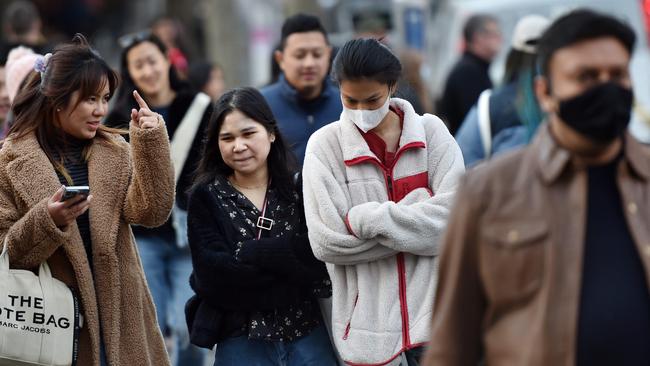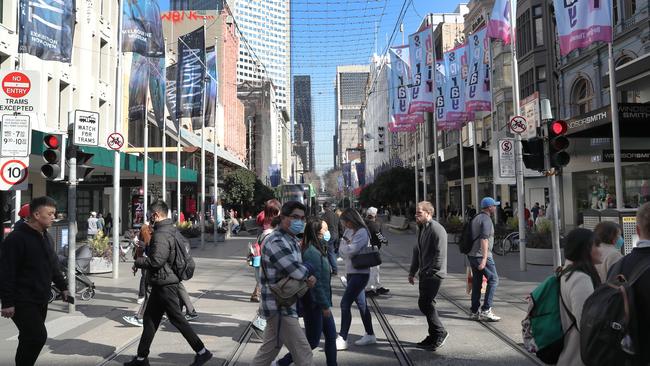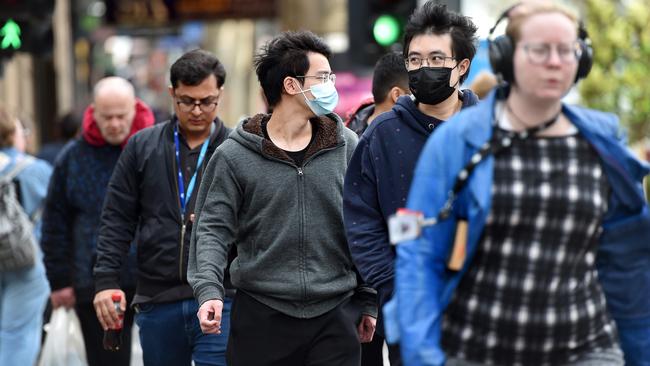What latest, worrying Victorian Covid figures actually mean
Health experts have urged Victorians to take precautions amid a worrying spike in Covid cases but say we’re not back in the “fear stage” yet.

News
Don't miss out on the headlines from News. Followed categories will be added to My News.
It is too early to determine the strength and impact of a new Omicron subvariant causing Covid cases to soar by nearly 25 per cent in a week, experts say.
It comes as the number of people becoming seriously ill and hospitalised has risen.
The worrying spike led health authorities to warn “we are at the start of another Covid-19 wave” and reiterate the need for booster vaccinations and preventive measures to stem the spread.
But Deakin University epidemiology chair Professor Catherine Bennett said it was “difficult to assess” the severity of the new strain that recently hit Australia.
“It’s actually really tricky with these new variants because they are playing out in different populations at different stages of prior immunity,” she said.
“We have quite a few new variants and that being talked about (but) we don’t have quite the same dominance, so that also makes it a bit harder to tease out what’s happening.
“It is difficult to assess.”
Professor Bennett said it was worth taking note of the case numbers but stressed we weren’t back in the “fear stage”.
“We have to watch it … we do have to keep an eye on it,” she added.
“So I think it’s just really following the advice that comes with these updates, not to say ‘OK, back into the fear stage’.
“Maybe we just have to be aware of that risk of exposure if it does push up a bit in Australia.
“(But) we’re not seeing anything like the BA1 wave when Omicron first hit.”

The Victorian Department of Health on Friday night revealed 8537 Covid cases had been reported in Victoria during the week, an increase of 24.7 per cent on the week before.
The average daily number of new cases this week was 1,220, it said
The number of active cases in Victoria had also increased to 7851, up from 5915 at the same time last week.
And 172 patients had been hospitalised, a 20.3 per cent increase on the same time the previous week.
Seven people were in intensive care and two on a ventilator.
“Reported Covid cases in Victoria increased this week, with most cases being reported in people aged over 65. Hospitalisations, now a better indicator of disease activity than cases, increased at similar rates while cases in intensive care remained steady,” the health department said in a statement.
“The increase in cases and hospitalisations, combined with an increase in the PCR positivity rate and antiviral prescriptions (up eight per cent in the past week), suggest a moderate increase in the number of COVID-19 infections in the community. These indicators show we are at the start of another COVID-19 wave.”
A total of 51 Covid related deaths were reported in the past week, with an average of seven deaths reported each day.
But in good news, there has been a 54.6 per cent decrease in the number of Covid deaths in the past month, compared to the month before.
Over the past three months, 4,585 Covid patients were hospitalised in Victoria.
Of those, 43.5 per cent had not received their third vaccine dose and 30.2 per cent were unvaccinated.

Victoria’s wastewater surveillance and clinical genomic testing program was actively tracking the emerging Omicron sub variants BQ.1 and XBB, that were driving significant case and hospitalisation waves overseas due to their ability to escape immunity from past infection (including BA.5) and waning immunity from past vaccination, the state government statement said.
“Surveillance shows the presence of multiple Omicron sub variants in Victoria including rapid growth of BQ.1 and XBB in the past month, with a combined prevalence of approximately 10 per cent in wastewater and clinical samples. Continued growth at these rates would see these sub variants overtake BA.5 as the dominant variant,” it said.
“With case numbers on the rise locally and internationally, particularly in Europe and in South-East Asia, Victorians are reminded that vaccination, masks, ventilation, testing, staying home when sick and COVID-19 treatments are highly effective at reducing transmission, illness and deaths and also protect the health system.”




